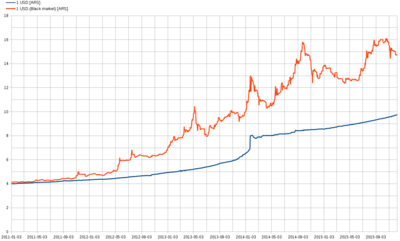Argentine currency controls (2011–15)
Argentina installed foreign exchange controls in 2011, at the beginning of the second presidency of Cristina Fernández de Kirchner. Those controls limited the ability to buy or sell any foreign currency. The restriction was informally known in Argentina as "Cepo cambiario" (Spanish: exchange clamp). The controls were lifted in December 2015, at the beginning of the presidency of Mauricio Macri.
History

The first restrictions were imposed on October 31, 2011. The Tax and Customs Authority, AFIP, required that individuals and businesses who sought to buy dollars request permission, which may depend of the financial status of the buyer. However, the implementation of the rules was arbitrary. In February, restrictions were applied to all international payments in dollars, such as imports. This also affected the ability of foreign investors to return their earnings to their own countries.[2]
The use of credit cards abroad was also restricted. As of May 2012, people could only buy dollars for 25% to 40% of their wages.[2]
In June 2012, AFIP forbade the purchase of dollars, except for a limited number of activities. As the country had a high inflation at that point, people used to buy dollars to keep the value of their money. The use of dollars for tourism received more limits a couple of months later: people would only receive the local money of the country that they visited, and only 7 days before the trip.[2]
By the end of 2015, the country had very low foreign reserves, and a high inflation.[3]
End of restrictions
Mauricio Macri, who opposed the Kirchners, promised in the 2015 presidential campaign that he would cancel the restrictions immediately, as part of the reforms to promote economic growth. The restrictions were lifted on December 17, a week after he took office. Before that, the minister of economy Alfonso Prat-Gay sought sources of financing, such as international banks and grain exporters.[3] It was estimated that the grain exporters had billions of dollars in stockpiled grain harvests, waiting for the changes to sell them.[4]
References
- ↑ "El dólar blue alcanzó un nuevo récord: cotizó a $16,11, a seis días de las elecciones". Retrieved 4 August 2016.
- 1 2 3 "Cepo cambiario: cronología de estos cuatro años de restricciones" [Exchange lockout: timeline of four years of restrictions] (in Spanish). La Nación. December 16, 2015. Retrieved December 17, 2015.
- 1 2 "Argentina lifts currency controls, floats peso in bid to boost economy". The Guardian. December 17, 2015. Retrieved December 17, 2015.
- ↑ Jonathan Gilbert (December 16, 2015). "Argentina Set to Devalue Its Currency". The New York Times. Retrieved December 17, 2015.
